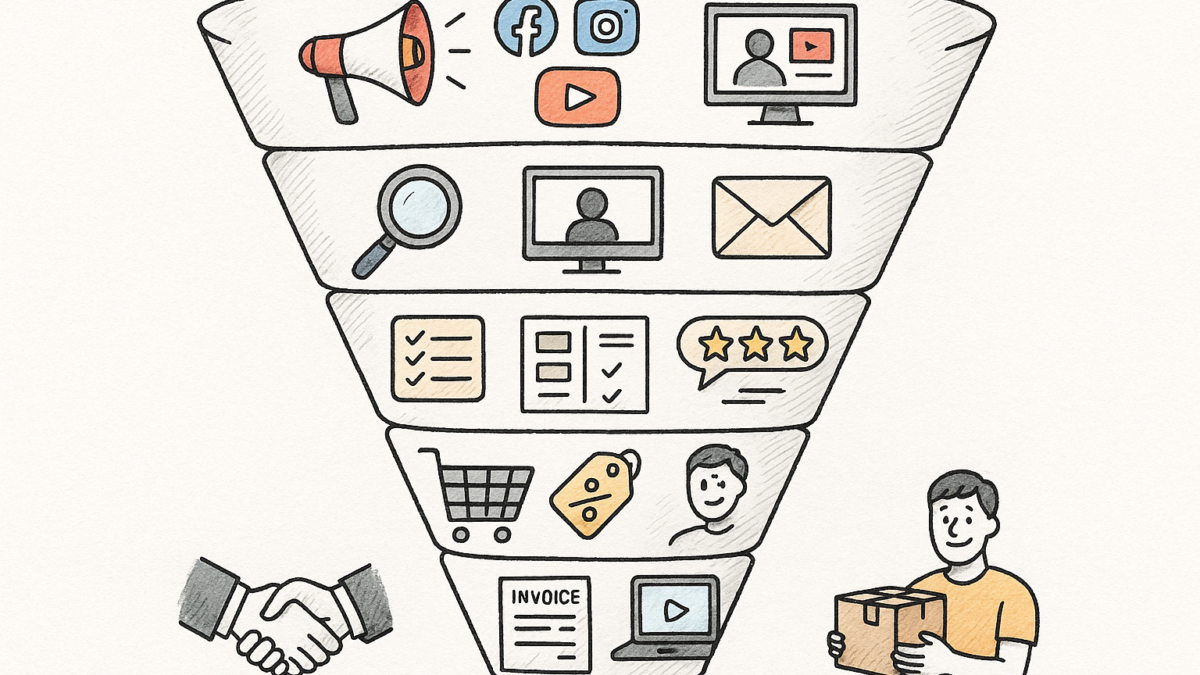Table of Contents
Introduction
Every customer journey begins with curiosity—and ends in conversion. The sales funnel is the roadmap that guides this journey. It’s not just a marketing buzzword—it’s the foundation of revenue growth for businesses of all sizes.
In this blog, we’ll break down what a sales funnel is, why it matters, the key stages involved, and how to build one that works.
What Is a Sales Funnel?
A sales funnel is a visual representation of the steps a prospect goes through before becoming a paying customer. It illustrates the buyer’s journey from initial awareness to final purchase, and sometimes beyond.
Think of it as a funnel: many people enter at the top, but only a portion emerge at the bottom as customers.
Key Characteristics of a Sales Funnel:
- Structured and measurable
- Customizable for different business models
- Focused on optimizing conversion at each stage
- Helps identify drop-offs and opportunities
Why Sales Funnels Matter in 2025
In today’s competitive digital environment, having a sales funnel is non-negotiable. It enables you to:
- Understand and influence customer behavior
- Increase conversion rates
- Reduce customer acquisition cost (CAC)
- Predict revenue with better accuracy
According to Salesforce, 68% of businesses with structured sales funnels see better ROI on their marketing investments.
Stages of a Sales Funnel
While the number of funnel stages may vary slightly depending on the model, the classic sales funnel has five core stages:
Awareness (Top of Funnel)
Goal: Get noticed by your target audience.
Tactics:
- Social media campaigns
- SEO content (blogs, videos, infographics)
- Online ads
- PR and media mentions
Example: A SaaS tool publishes an educational YouTube video titled “How to Save Time with Automation.”
Interest
Goal: Spark curiosity and drive engagement.
Tactics:
- Email newsletters
- Case studies
- Retargeting ads
- Free tools or webinars
Tip: Use analytics to track bounce rates and time spent on content to assess engagement.
Consideration
Goal: Help prospects evaluate your product/service.
Tactics:
- Product comparison guides
- Customer testimonials
- Free trials or demos
- Interactive content like ROI calculators
Stat: 47% of B2B buyers consume 3–5 pieces of content before contacting a sales rep (Demand Gen Report).
Intent
Goal: Push toward the buying decision.
Tactics:
- Discount offers
- Personalized email sequences
- Live chat or consultations
- FAQ and pricing pages
Purchase (Bottom of Funnel)
Goal: Convert the prospect into a customer.
Tactics:
- One-click checkout
- Secure payment options
- Onboarding assistance
- Thank-you emails
Post-sale touchpoints are key to reinforcing the buyer’s decision and encouraging repeat business.
Optional Stage: Loyalty & Advocacy
In 2025, smart businesses are expanding their funnels to include post-purchase stages focused on:
- Customer retention
- Upselling & cross-selling
- Referrals and reviews
- Loyalty programs
Remember: acquiring a new customer costs 5x more than retaining an existing one.
How to Build a Sales Funnel in 5 Steps
- Identify your ideal customer (buyer persona)
- Map out the funnel stages based on the customer journey
- Create tailored content and offers for each stage
- Implement tracking and automation tools (like aalign.io, HubSpot, or ActiveCampaign)
- Analyze and optimize performance continuously
Sales Funnel Example: B2B SaaS Funnel
| Stage | Content/Action | Tool Used |
|---|---|---|
| Awareness | Blog post: “Top Workflow Tools 2025” | Organic search |
| Interest | Free checklist download | Email capture form |
| Consideration | Demo request page | CRM & lead scoring |
| Intent | Personalized sales email | Sales automation tool |
| Purchase | Subscription sign-up | Stripe or CRM system |
Sales Funnel Tools You Should Know
- Google Analytics 4 – Funnel tracking & behavior flow
- HubSpot – Full-funnel CRM & marketing automation
- ClickFunnels – Drag-and-drop sales funnel builder
- aalign.io – Funnel alignment, lead nurturing & progression
- Unbounce – Optimized landing pages
Common Sales Funnel Mistakes to Avoid
- Targeting too broad an audience
- Skipping lead qualification
- No clear CTA at each stage
- Ignoring funnel performance metrics
- Not aligning sales & marketing teams
Final Thoughts: Funnels Turn Traffic into Revenue
A well-structured sales funnel bridges the gap between marketing and sales. It’s not just a visual—it’s a system for driving conversions, growing pipeline, and scaling revenue predictably.
In 2025, customers are more informed than ever. Your funnel must be tailored, value-packed, and constantly optimized to meet their evolving needs.
Ready to Optimize Your Funnel?
At iTMunch, we help B2B brands build and scale data-driven funnels using expert content strategies, automation, and CRM integrations.





